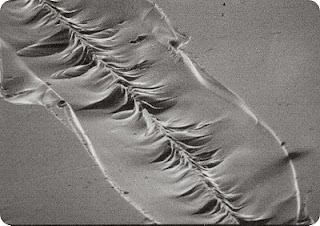So why does it scratch?
 |
| A scratch on a plate at high magnification |
To scratch a pottery glaze you need a material of similar or greater hardness. So pottery can scratch itself. Glaze on glaze contact will cause surface damage and when there is excessive or repeated damage the eye sees it as a scratch!
So a scratch isn't a scratch until you can see it!
Glazed pottery is susceptible to surface damage as soon as it comes out of the production kiln. During the manufacturing process care is taken to avoid excessive damage by careful handling of the pieces, the use of protective sleeves and optimum packaging for transport.
However in our homes damage to our pottery happens all the time. For example each time we use a plate it is damaged by contact with other pottery. Creating a plate stack to clear the table, placing plates on each other in the sink, washing them in detergent, sliding them into clean stacks all contribute to damage. Clearly there is a cumulative effect of this damage which results in the appearance of scratching.
So how can scratching be avoided?
Taking care to handle the ware gently, in a similar way to the manufacturer, will extend the life of the pottery. Using protective sleeves and avoiding sliding contact are particularly important. In addition the ware can be adversely affected by detergents and strong acids so prolonged contact with these chemicals should be avoided.
Whilst these precautions may seem fanciful and few people will take the time or effort to follow them, they do work!
Alternatively, if all this is too much then there is one other thing you can do......buy pottery that has a glaze that is not highly glossy and has a less than mirror like finish! Whilst this does not reduce the damage, scratches normally visible to the naked eye are less apparent, and the ware appears less scratched.
Alternatively why not test your pottery knowledge with my quick pottery quiz
More information and other technical articles on pottery and ceramics can be found at my website www.pottersfriend.co.uk
Go now to sign up for my free newsletter.